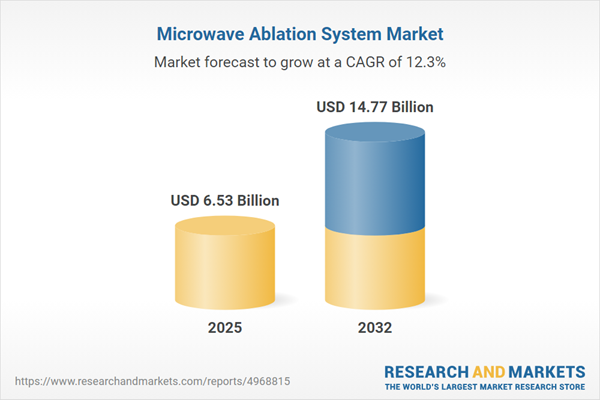Speak directly to the analyst to clarify any post sales queries you may have.
The microwave ablation system market is transforming oncology care with a focus on accuracy, operational efficiency, and system integration—key considerations for senior leaders evaluating investments in advanced cancer technology.
Market Snapshot: Microwave Ablation System Market Dynamics
In 2024, the global microwave ablation system market reached USD 5.83 billion, reflecting a robust 12.32% compound annual growth rate. This notable expansion highlights a growing worldwide shift toward advanced cancer treatments that promote shorter recovery periods and patient-centered outcomes. Leading cancer care centers are adopting these systems, which continue to influence healthcare models in both mature and emerging markets. Clinical adoption is rising as providers seek alternatives to traditional surgery, while streamlined processes and strategic regional initiatives accelerate adoption across diverse healthcare infrastructures. These dynamics are shaping procurement, operational models, and long-term planning in oncology.
Scope & Segmentation of the Microwave Ablation System Market
This report delivers targeted intelligence for executives overseeing procurement, systems integration, and oncology technology investments. Each market segment and technological category addresses unique organizational needs and strategic considerations vital for effective resource allocation and competitive market entry:
- End Users: Ambulatory surgical centers require solutions that enhance patient throughput and optimize procedure times. Cancer research institutes depend on flexible systems that align with evolving research demands. Hospitals look for scalable and interoperable platforms to ensure department-wide coordination and patient management.
- Frequency Categories: Devices at 2.45 GHz and 915 MHz facilitate procedural customization, support diverse oncology requirements, and help clinicians align treatment parameters with individual patient profiles.
- System Types: Multi-applicator platforms increase productivity, allowing for the simultaneous treatment of several lesions. Single applicator models offer precise targeting for complex cases requiring individualized attention.
- Applications: Microwave ablation systems are used for kidney, liver, and lung cancer procedures. These devices fit both inpatient and outpatient workflows, providing flexibility for diverse oncology practices.
- Regional Coverage: The report analyzes markets across the Americas, Europe, Middle East & Africa, and Asia-Pacific, with detailed insights for the United States, United Kingdom, Germany, China, and Japan, as well as commentary on opportunities in Latin America, Africa, and Southeast Asia.
- Key Companies: Industry leaders such as Medtronic plc, Johnson & Johnson, AngioDynamics, Erbe Elektromedizin GmbH, Mermaid Medical, Olympus Corporation, Taewoong Medical, JW Medical Systems, RF Medical, and Shenzhen Wellead Medical contribute to market advancements and innovation.
Key Takeaways for Senior Decision-Makers
- Microwave ablation systems streamline collaboration between clinical and operational teams, supporting effective oncology service delivery and workflow enhancement.
- Innovative applicator and antenna designs drive reliable system performance, facilitating easier integration into established treatment pathways and supporting consistent clinical routines.
- Refined frequency control offers oncologists increased flexibility to tailor patient therapies, driving greater adoption of precision-focused care approaches across institutions.
- Modular and scalable architectures make system deployment practical for facilities of varying size and specialty, including clinics, hospitals, and research organizations.
- Successful implementations rely on robust infrastructure planning and cross-functional collaboration between procurement, clinical, and IT teams, ensuring alignment with strategic objectives.
- Providers increasingly prioritize interoperability and compatibility to ensure systems can keep pace with evolving clinical practices and emerging research needs.
Tariff Impact and Strategic Responses
Recent U.S. tariff adjustments have contributed to increased supply chain expenses for microwave ablation system manufacturers. Organizations are responding by evaluating nearshoring options, diversifying supplier networks, and updating production processes. Procurement teams now emphasize transparency in sourcing, and industry groups are advocating for regulatory updates that balance innovation with clinical safety standards.
Methodology & Data Sources
Insights for this report are based on direct interviews with oncology clinicians, procurement managers, and supply chain executives. These primary findings are supplemented by analysis of peer-reviewed articles, clinical registries, and applicable regulatory guidelines, supporting technology investment decisions in the B2B context.
Why This Report Matters
- Helps senior executives align procurement and technology strategies with global oncology standards and current best practices.
- Delivers actionable market intelligence to support confident investments and build competitive advantage through segment-specific analysis.
- Provides practical direction for navigating complex cancer care models and managing operational and regional differences in oncology service delivery.
Conclusion
Microwave ablation systems are shaping the future of oncology by enabling organizations to optimize technology adoption and improve operational readiness. Leaders who act strategically will strengthen their position to address future clinical challenges and market shifts.
Additional Product Information:
- Purchase of this report includes 1 year online access with quarterly updates.
- This report can be updated on request. Please contact our Customer Experience team using the Ask a Question widget on our website.
Table of Contents
3. Executive Summary
4. Market Overview
7. Cumulative Impact of Artificial Intelligence 2025
Companies Mentioned
The companies profiled in this Microwave Ablation System market report include:- Medtronic plc
- Johnson & Johnson
- AngioDynamics, Inc.
- Erbe Elektromedizin GmbH
- Mermaid Medical
- Olympus Corporation
- Taewoong Medical Co., Ltd.
- JW Medical Systems Co., Ltd.
- RF Medical Co., Ltd.
- Shenzhen Wellead Medical Co., Ltd.
Table Information
| Report Attribute | Details |
|---|---|
| No. of Pages | 181 |
| Published | October 2025 |
| Forecast Period | 2025 - 2032 |
| Estimated Market Value ( USD | $ 6.53 Billion |
| Forecasted Market Value ( USD | $ 14.77 Billion |
| Compound Annual Growth Rate | 12.3% |
| Regions Covered | Global |
| No. of Companies Mentioned | 11 |









